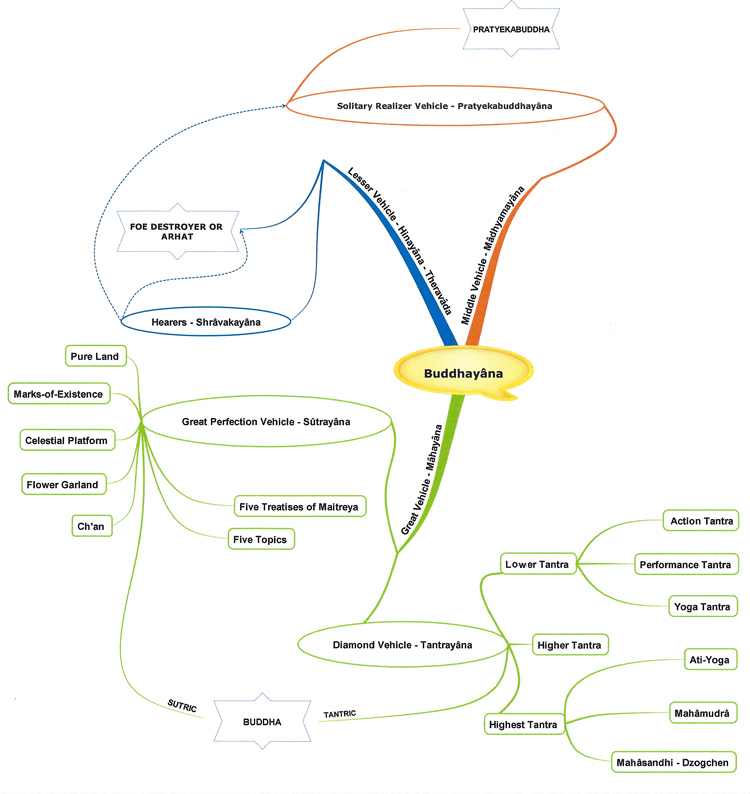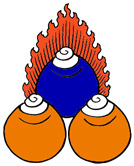| |

Studies
in
Buddhadharma
On the Buddhayâna : the One Buddha Vehicle
 Contents
Contents  SiteMap
SiteMap

"These three things,
monks, are conducted in secret, not openly. What three ? Affairs of
woman, the mantras of the Brahmins, and wrong view. But these three
things, monks, shine openly, not in secret. What three ? The Moon,
the Sun and the Dharma and Discipline proclaimed by the Tathâgata." -
Ekottarâgama (Anguttara-nikâya), 3:129.

|
As a pragmatical & non-elitist religious philosophy, the Buddhadharma applies to everyday life
as well as to abstract thought. It has "84.000 Dharma doors"
leading to "nirvâna",
the wisdom-mind of enlightenment attending to the ultimate nature of
phenomena, emptiness.
"Nirvâna" is either (a) the bliss of
liberation for oneself alone (as
in the Hînayâna),
(b) the final enlightenment of
Buddhahood realized with
Mahâyâna
Bodhicitta,
the mind of enlightenment for the sake of all sentient beings, in
particular "ultimate Bodhicitta", the wisdom-mind realizing the true
nature of phenomena,
emptiness or (c) the spontaneously self-perfected
recognition of the inseparability of emptiness & clarity, as in
Dzogchen.
Buddhadharma or Buddha's teachings on the Buddhayâna or "vehicle of
enlightenment" is divided into Sûtra, Tantra and Dzogchen. Each of these
has a different base, ground or view, a different path and thus a
different fruit or result. Compare this to a three-tiered building.
|
In a general utilitarian
sense, cognitive systems bringing benefits to a large number of
sentient beings are worthy of respect. These "vehicles" or
"paths" help the
individual to cross the ocean of suffering and to find better
physical, psychological, social, economical & spiritual conditions.
Such increased happiness and surplus always benefits others as well.
The Buddhadharma points to three such vehicles ("yânas") :
-
the human vehicles
:
invented by human beings for human beings, these secular systems try to
guarantee their basic needs : food, housing, health care, education,
family life, social services, a system of law, democracy, etc. Despite the
many international organisations, humanity has not yet been able to
establish a just human vehicle worldwide. Even today, when this should
already be the case, it is shamefully not so ! On the contrary, the
division between those who benefit from such systems and those who do not
is becoming increasingly wider. Social injustice is rampant worldwide ! Hence, one may doubt the stand-alone effectiveness of
these vehicles. It seems as if they incorporate the very causes of the
suffering they intend to relief ;
-
the Divine vehicle
:
invented by the gods for human beings,
Buddha spoke of the "Brahma Vehicle", compromizing
meditative techniques aiming to achieve
the highest possible form of life within "samsâra".
In particular, the Divine vehicle promotes the concentrations &
absorptions of the form and formless realms of cyclic, conditioned
existence, aiming at the highest "Jhâna", the so-called "Peak of Samsâra"
(or cosmic consciousness). References to these states are found in all
spiritual systems and religions. This vehicle leads to Divine states of
consciousness and, according to the Buddha, rebirth as a "Deva" or Deity
in the God-realm of cyclic existence. However, the Buddha experienced why
these states, although extremely blissful & lasting for a very long time,
are, at the end of the day, also transient & painful and so not the result
sought. Indeed, Buddhists wish to attain the lasting peace of "nirvâna",
i.e. a condition which effectively never ends ! So in final analysis, the
power of death must be eradicated, implying one is able to control one's
rebirth or stop rebirth altogether, which belongs to liberation &
Buddhahood ;
-
the Buddha Vehicle
: the Triyâna or "Three Vehicles"
taught by
Buddha Śâkyamuni are actually one
vehicle, the Buddhayâna or Buddha Vehicle. In other words, the
Individual or Lesser Vehicle ("Hînayâna"),
the Great Vehicle ("Mahâyâna")
and the Diamond Vehicle ("Vajrayâna")
are three aspects of the one Buddha Vehicle, leading
those gone for Refuge in the Three Jewels to lasting, true peace or "nirvâna",
i.e. "passing beyond suffering". This is no longer a
samsaric, mundane state of mind (secular or Divine), but an ineffable, totally transcendent,
supramundane "Body of
Truth" or "Dharmakâya", introduced by direct experiential
recognition only.
The Buddha Vehicle
accommodates various types of seekers and can be seen as a
three-tiered building, each with its view, path & fruit.
Reformulating these divisions in more operational terms,
classifying the teachings from "lesser" to "highest", we arrive at :
|
Hînayâna :
personal
liberation |
Hearer |
view : Selflessness of persons
path : purification
fruit : liberation of Arhathood |
|
Solitary Buddha |
|
Arhat or Foe Destroyer |
|
Mahâyâna :
enlightenment
of all sentient
beings |
Sûtrayâna |
view : Mâdhyamaka / Yogâcâra
path of renunciation
fruit : distant Buddhahood |
|
Tantrayâna |
view : Śûnyâtâyâna
path of transformation
fruit : near Buddhahood |
|
Ati-Yoga |
view : total primordial purity
path of self-liberation
fruit : immediate Buddhahood |
So, depending on their
ability to realize a view & its concordant path, the Buddha Vehicle
forsees each type of
practitioners to generate his or her own co-relative spiritual fruit :
-
listening to the teacher, the Hearer is liberated for
himself alone, but only realized the identitylessness of persons ;
-
having eliminated all fetters, the
Arhat or Foe Destroyer is no longer subject to rebirth
(liberated from cyclic existence), but not yet a Buddha ;
-
on his own, by his own
efforts & for himself alone,
the Pratyekabuddha or "private Buddha" is liberated, but only realizes the
identitylessness of persons. He does not teach the Dharma (except
morality), does not bring others to enlightenment (except a few students
drawn to him) and arises when there is no Buddha to teach ;
-
the Sutric
Bodhisattva is dedicated to save all sentient beings
(Bodhicitta),
also
realizes the identitylessness of all phenomena, approaches the fruit by
way of dual cognition (the
Two Truths),
but has to work very hard for an extremely long time before attaining
the goal of final elightenment, Buddhahood ;
-
the Tantric Bodhisattva generates
relative & absolute
Bodhicitta, has a complete realization of emptiness, still approaches the
fruit by way of the
Two Truths,
has the superior method of Deity Yoga, but
may still need several rebirths before enjoying the fruit (or achieve it
in a single lifetime) ;
-
the Ati-Yoga Bodhisattva generates Bodhicitta, has a
correct view on emptiness and a non-causal, spontaneous, nondual, single
introduction to the ultimate, self-liberating all possible thoughts
immediately. He may achieve Buddhahood in a single lifetime. He transcends both cyclic existence and "nirvâna". By way of
the view, the path is the fruit ...

|
|




